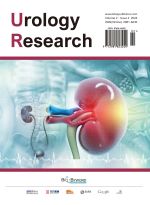Abstract
Objective: To explore the effects of Lidan Huashi Pills on the glutathione peroxidase (GSH-Px) activity and growth of calcium oxalate crystals in the kidneys of rats. Methods: 30 rats were randomly divided into a blank group, a model group, and an experimental group, with 10 rats in each group. The blank group was free to eat and drink water for 8 weeks; the ethylene glycol method was used for the standard calcium oxalate crystal modeling in the control group and experimental group for 4 weeks. The model group was given free feeding and physiological saline (2 ml/d) by continuous gavage for 4 weeks; the experimental group was given free feeding and Lidan Huashi Pills (450 mg/kg, 2 ml/d) by continuous gavage for 4 weeks. After 4 weeks, all rats were euthanized, and the left kidney was taken for GSH-Px level detection. The right kidney was stained with hematoxylin and eosin (H&E) to observe the formation of calcium oxalate crystals. Results: After 4 weeks of modeling, the urinary calcium levels in the model group and experimental group significantly increased compared to the blank group (868.00 ± 39.29 vs 929.40 ± 33.61, P < 0.05), indicating successful modeling. The urine calcium ion concentration in the experimental group after modeling was significantly lower than that in the model group (929.40 ± 33.61 vs 888.60 ± 25.92, P < 0.05). The grading score of calcium oxalate crystals in the model group was significantly higher than that in the blank group (P < 0.05); the grading score of calcium oxalate crystals in the experimental group was lower than that in the model group, and the difference was not statistically significant (P > 0.05). The GSH-Px activity in the left kidney of the model group was significantly lower than that of the blank group [203.49 (208.21, 144.22) vs 494.91 (431.32, 538.18), P < 0.05); the GSH-Px activity in the left kidney of the experimental group was significantly higher than that of the model group [433.60 (383.86, 504.49) vs 203.49 (208.21, 144.22), P < 0.05). Morphological observation and H&E staining suggest that the formation of right kidney crystals and inflammation in the experimental group are between the blank group and the model group. Conclusion: Lidan Huashi Pills can enhance the serum GSH-Px activity in rats and inhibit the growth of calcium oxalate crystals and inflammatory response in the kidneys, thus playing a role in preventing and treating urinary tract stones.
References
Morton A, Tariq A, Dunglison N, et al., 2024, Etiology and Management of Urethral Calculi: A Systematic Review of Contemporary Series. Asian Journal of Urology, 11(1): 10–18.
Zhi W, Li L, Ye CL, et al., 2024, Carboxymethylated Rhizoma alismatis Polysaccharides Reduces the Risk of Calcium Oxalate Stone Formation by Reducing Cellular Inflammation and Oxidative Stress. Urolithiasis, 52(1): 63.
Yan L, Pan H, 2022, An Analysis of the Theory of Neisseria gonorrhoeae in the Journal of Pathogenic and Epidemic Diseases. Hubei Journal of Traditional Chinese Medicine, 44(03): 38–41.
Jia H, 2022, Clinical Study of Lidan Fossil Pill in the Treatment of Urinary Lithiasis with Lower Jiao Stagnation Type, dissertation, Nanjing University of Traditional Chinese Medicine.
Xu Y, Hao Z, 2022, The Latest Progress in Animal Models of Urinary Tract Stone. Journal of Clinical Urology, 37(07): 559–563.
Sha C, Chen W, Zeng M, et al., 2022, Study on the Preventive and Therapeutic Effects of Jineijin on Rat Renal Calcium Oxalate Stones. Chinese Journal of General Medicine, 20(09): 1473–1476.
Wang Q, 2018, Study on the Prevention of Calcium Oxalate Stone Formation and Its Mechanism by Lianqian Cao, dissertation, Nanjing University of Traditional Chinese Medicine.
Zhang Z, Shen Y, Wang Z, 1997, Pharmacodynamic Experiments on Lidan Fossil Pills. Shi Zhen, Chinese Medical Research, 1997(02): 57–58.
Wang X, Zhang Y, Han X, et al., 2020, Overexpression of miR-30c-5p Reduces Cytotoxicity Through ATG5 and Inhibits the Formation of Kidney Stones. International Journal of Molecular Medicine, 45(2): 375–384.
Cakir OO, Culha MG, Arisan S, et al., 2017, Decreased Serum Antioxidant Enzyme Levels in Patients with Urinary Calcium Oxalate Stones. Urol Journal, 14(4): 4015–4019.
Khan SR, 2013, Reactive Oxygen Species as a Molecular Regulator for the Formation of Calcium Oxalate Kidney Stones: Clinical and Experimental Research Evidence. Uro Journal, 189(3): 803–811.
Chen P, Liu D, Li Z, et al., 2021, Research Progress on the Correlation Between Calcium Oxalate Stones and Oxidative Stress. Jiangsu Medical Journal, 47(01): 85–89.
Yan C, Li S, Ma W, et al., 2022, Analysis of the Effect of Febuxostat in the Treatment of End-Stage Renal Disease with Hyperuricemia and the Influencing Factors of Cardiovascular Events in Patients. Journal of North Sichuan Medical College, 37(09): 1184–1189.
Liu C, 2022, Antioxidant Effects and Mechanisms of Recombinant Glutathione Peroxidase 1 and 4, dissertation, Jilin University.
